15 must-see naked-eye skywatching events this year
The 2025 skywatching guide includes a rare sunrise solar eclipse, an occultation of Mars and three supermoons. Here are the dates you need to know.
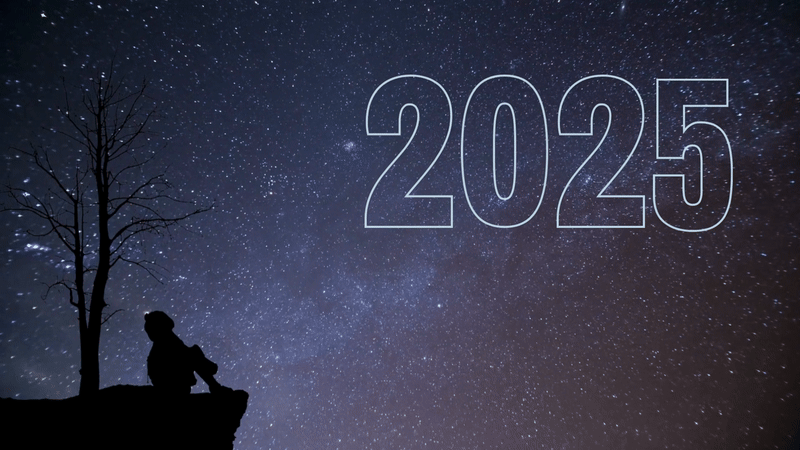
- 1. Quadrantid meteor shower
- 2. Mars gobbled up by the Wolf Moon
- 3. Mars at opposition
- 4. A crescent Venus at its brightest
- 5. "Devil's horns" at sunrise
- 6. Lyrid meteor shower
- 7. Eta Aquarid meteor shower
- 8. A crescent moon visiting the Pleiades
- 9. Delta Aquariid meteor shower
- 10. Conjunction of Venus and Jupiter
- 11. A second partial solar eclipse
- 12. Saturn at opposition
- 13. Draconid meteor shower
- 14. A spectacular supermoon
- 15. Leonid meteor shower
This year skywatchers can look forward to a series of stunning celestial events, including a bright Mars occulted by the Wolf Moon, Venus at its brightest, a spectacular "devil's horns" solar eclipse, and plenty of meteor showers peaking under moonless night skies.
Although many of these events are visible to the naked eye, a nice pair of binoculars and a good beginner telescope can significantly enhance your experience.
Here are 15 must-see skywatching events to mark on your calendar.
1. Quadrantid meteor shower: Jan. 3, 2025 (around midnight)
Although the Quadrantid meteor shower is mostly ignored by skywatchers in the Northern Hemisphere because it occurs during the winter, the Quadrantids are more prolific than most meteor showers. In addition to bringing up to 120 "shooting stars" per hour at their peak after dark on Jan. 3, the Quadrantids often produce a few superbright "fireballs." The moon will be below the horizon this year, so expect a good show if the skies are clear.
2. Mars gobbled up by the Wolf Moon: Jan. 13-14, 2025 (before midnight)

Mars will be spectacularly bright throughout January 2025, but this is the best night to catch it. Although the entire globe can watch the moon appear to pass close to Mars, North America gets a front-row seat to see the Red Planet disappear behind the almost full Wolf Moon. The exact time to view it depends on your location, but from Washington, D.C., Mars will disappear behind the moon at 9:16 p.m. EST and reappear at 10:31 p.m. EST on Jan. 13, according to In-The-Sky.org, which gives the times for all locations.
3. Mars at opposition: Jan. 15, 2025 (all night)
Just a couple of nights after its occultation by the full moon, Mars will reach its full phase, called opposition. This happens only once every 26 months, and it's hard to miss it because the Red Planet will be prominent all night for a few weeks on each side. Mars will reach perigee — its closest point to Earth — a few days earlier, on Jan. 12.
4. A crescent Venus at its brightest: Feb. 19, 2025 (after sunset)
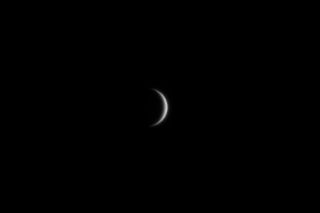
There isn't just one night in 2025 to observe Venus. However, Feb. 19 will offer an exceptional view because the "evening star" will be at its closest point to Earth. This also means it will be in its slimmest crescent phase. That's something seen only on Venus and Mercury from Earth. From Jan. 11 to Feb. 19, it will be possible to see Venus transform from half-lit to 13% lit, but only if you use a telescope.
Get the Space.com Newsletter
Breaking space news, the latest updates on rocket launches, skywatching events and more!
5. "Devil's horns" at sunrise: March 29, 2025 (sunrise)
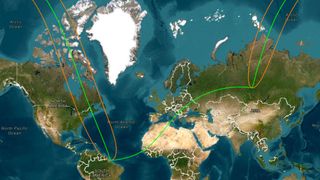
It may not match the total solar eclipse on April 8, 2024, but another solar eclipse will be visible from North America in 2025. This one, however, will be entirely different and far less dramatic. A partial eclipse will already be underway as the sun rises in North America. The event will be best seen from Atlantic Canada, Quebec and Maine, where a crescent sun will rise such that two separate solar "horns" will appear momentarily on the eastern horizon.
6. Lyrid meteor shower: April 21-22, 2025 (midnight)
A waxing crescent moon will set before midnight on April 21 to clear the way for the peak of the Lyrid meteor shower. Expect to see between 10 and 20 "shooting stars" per hour, all caused by dust and debris left in the inner solar system by Comet C/1861 G1 (Thatcher). There's a strong possibility of spectacular fireballs during the Lyrids.
7. Eta Aquarid meteor shower: May 6-7, 2025 (midnight)
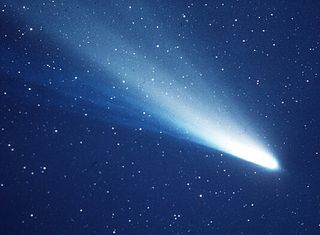
The Eta Aquarids are caused by the debris left in the inner solar system by Halley's Comet, which is due back in 2061. At its peak, the Eta Aquarid meteor shower will feature up to 60 shooting stars per hour. It's best seen in the Southern Hemisphere; only about half that number of meteors will be visible from the Northern Hemisphere.
8. A crescent moon visiting the Pleiades: July 20, 2025 (before sunrise)

A 24%-lit waning crescent moon will rise alongside the Pleiades open cluster of stars. Our natural satellite will move through these sparkling stars throughout the night, with a close conjunction visible an hour before sunset. Astrophotographers will be out in force.
9. Delta Aquariid meteor shower: July 28-29, 2025 (after dark)
Expect about 20 shooting stars per hour during this annual peak of the Delta Aquariids. This year, it will take place after a waxing crescent moon has already set, leaving the skies dark. This meteor shower is best viewed after midnight from either hemisphere. However, whereas most meteor showers have a defined peak night, this one rambles on for much of late July and early August.
10. Conjunction of Venus and Jupiter: Aug. 12, 2025 (before sunrise)
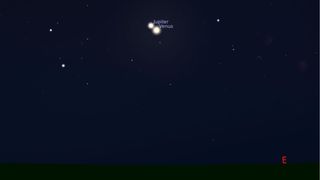
This year's Aug. 12 peak of the Perseid meteor shower — the most famous and prolific meteor shower of the year — will be largely ruined by strong moonlight. As cosmic compensation, we'll get a beautiful conjunction between the two brightest planets in the solar system. Look east an hour before sunrise to see Jupiter at magnitude -2 and Venus at magnitude -4; they will appear almost as one.
11. A second partial solar eclipse: Sept. 21, 2025 (daytime)
This year's second partial solar eclipse will be best viewed from New Zealand, where 58% to 73% of the sun will be blocked by the moon, depending on the exact location. An 80% partial eclipse will be visible from the Southern Ocean midway between New Zealand and a remote part of Antarctica; the more-visited Antarctic Peninsula will see only a 12% partial eclipse shortly before sunset.
12. Saturn at opposition: Sept. 21, 2025 (all night)
Saturn will appear at its brightest as Earth passes between the ringed planet and the sun in late September. This is the best time to view Saturn through a small telescope, though 2025 is arguably the least-impressive year for over a decade to do that. Every 13.5 years, the rings line up with our line of sight to Saturn, so we see them side-on. That happens in March 2025, effectively making the rings near-invisible for the rest of the year.
13. Draconid meteor shower: Oct. 8-9, 2025 (after sunset)
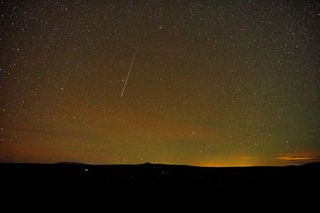
The Draconids — the only annual meteor shower to peak not at midnight but in the early hours after sunset — will get a boost in 2025. First, the moon will be a waning gibbous rising over an hour after sunset, so absent from the post-sunset night sky. Plus, the comet that causes the Draconids — Comet 21P/Giacobini-Zinner — will loop around the sun on its 6.6-year orbit. Expect about 10 shooting stars per hour.
14. A spectacular supermoon: Nov. 5, 2025 (dusk)
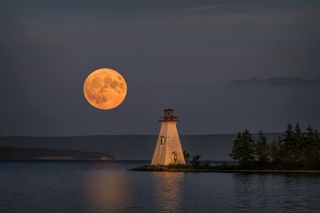
Supermoons happen because the moon's orbit is elliptical, so some full moons are closer than others, making them appear bigger and brighter from Earth. There will be three supermoons in 2025 — on Oct. 7, Nov. 5 and Dec. 4 — with November's being the biggest and brightest since 2019. Catch it at moonrise for the full "big moon" effect.
15. Leonid meteor shower: Nov. 17-18, 2025 (midnight)
This annual meteor shower tends to go berserk every 33 years, but sadly, the next bonanza isn't due until 2032-33, according to Sky At Night. This year, the peak of the Leonid meteor shower coincides with a slim waning crescent moon, which means dark, moonless skies that could yield about 15 shooting stars per hour close to the peak. They're caused by Comet Tempel-Tuttle, which will next revisit the inner solar system in 2031.
Join our Space Forums to keep talking space on the latest missions, night sky and more! And if you have a news tip, correction or comment, let us know at: community@space.com.

Jamie is an experienced science, technology and travel journalist and stargazer who writes about exploring the night sky, solar and lunar eclipses, moon-gazing, astro-travel, astronomy and space exploration. He is the editor of WhenIsTheNextEclipse.com and author of A Stargazing Program For Beginners, and is a senior contributor at Forbes. His special skill is turning tech-babble into plain English.
-
Rickycardo Again, they left out the Moon passing through the Pleiades star cluster on January 9. Visible from North America.Reply
Most Popular

